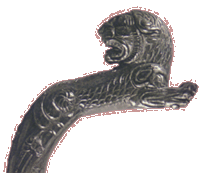 |
THE LADLES,
or kyathoi, from the Güre tumuli are all silver and belong
to a dipper type that was used in Anatolia and Palestine in the
Persian and Hellenistic eras and that may be Achaemenid. The rendering
of animal terminals with foreparts in the round and hindquarters
in relief on the handles of nos. 30 and 107 is Achaemenid. Animal
head terminals on examples from Sardis, the Bandirma region and
from Gezer and Tell el-Far'ah in Palestine are also of Achaemenid
type (although the nude girl on the handle stem of one from Tell
el Far'ah is a Palestinian feature). Similar to the Ikiztepe examples
are two in the British Museum (WA 116410, 118014). Two later examples,
one from Prusias in Bithynia, the other reportedly from the Bandirma
region, date to the 4th century BC and the Hellenistic era respectively.
The type is not Greek, although analogous dippers were used in
Greece and appear in Attic black-figure and red-figure symposium
scenes.
THE GÜRE tumuli do not include large containers of the kind with
which one might expect ladles to be associated. Ladles from graves
in Palestine were deposited together with bowls of several kinds;
the example from the grave at Sardis rested in a small spouted
dish like no. 59. The use of ladles by royal cupbearers to taste
wine before offering it to the king is reported by Xenophon.
|











